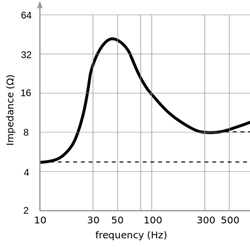
AC/DC
The other reason that the light bulb doesn’t meter the resistance predicted by Ohm’s Law is that the it’s an AC device. Here’s where we need to make the distinction between resistance and impedance: “resistance” is the total opposition to current flow in a DC circuit, such as a flashlight.
However, with AC, there’s more to it. AC circuits will exhibit the same DC resistance, but there is additional opposition to current flow created by circuit components such as capacitors and inductors. This additional opposition is due to the way these components react to the alternating current, and is called reactance (X).
The AC circuits opposition to current flow consists of both resistance and reactance, so now we need a new term to describe the total opposition. All things considered, how much does the circuit impede current flow? This is its impedance, represented by a “Z.” (Also keep in mind AC resistance, which is a frequency at which the voltage and current are in-phase (phase angle = 0), such as the resonant frequency of a loudspeaker.)
As with resistance, reactance is also measured in ohms, but we can’t simply sum the two. A circuit having 4 ohms of resistance and 3 ohms of reactance does not have an impedance of 7 ohms. Conceptually, resistance and reactance are considered as two sides of a right triangle, with a 90-degree angle between them.
The impedance is represented by the length of the hypotenuse, so we can use the Pythagorean Theorem (c2 = a2 + b2) to find it. You can see that 4 ohms of resistance (R = 4 ohms) and 3 ohms of reactance (X = 3 ohms) produce an impedance of Z = 5 ohms (Figure 2).
There are two types of reactance: capacitors cause capacitance, and inductors cause inductance. These act opposite each other, meaning they subtract, not add. If a circuit exhibits 8 ohms of inductive reactance (XL) and 6 ohms of capacitive reactance (XC) then the total reactance is 8 – 6 = 2 ohms, which is the value we would use in the impedance triangle. This is like walking 8 meters in one direction, then turning around and walking 6 meters back – you’re only 2 meters from where you started. Since the light bulb’s filament is inductive, this accounts for the rest of the discrepancy.
R Vs. X
The reason we need to draw a distinction between resistance and reactance is that reactance changes based on the frequency applied to the circuit. This makes sense: Reactance is the circuit’s response to alternations in the current direction, so it follows that changing the speed of these alternations would affect the reactance.
In terms of electricity, such as in the case of our light bulb, this is a moot point since North American power is always distributed at 60 Hz, so reactance is a one-and-done calculation. This is how electricians use the blanket term of “resistance” though they’re technically describing impedance. For them, frequency is a constant and therefore so it reactance. (Note, though, that even at 60 Hz there are still resistive and reactive properties that must be considered. A load can be purely resistive, purely reactive, or a combination. This is accounted for by the power factor, and many modern amplifier employ power factor correction to improve their efficiency.)
When it comes to audio signals, the situation is much more complex: our frequencies vary from 20 Hz to 20 kHz, three orders of magnitude. The huge frequency range means that our circuits will react far differently at 20 Hz than they will at 20 kHz. I won’t impede you with my formulas (ha!) but the calculation of XL and XC incorporate a frequency variable, Ƒ, without which it’s impossible to do the calculation. It’s therefore impossible to discuss the behavior of a reactive circuit unless we consider frequency.
The formula for capacitive reactance (XC) is a fraction with the f in the denominator. As frequency increases, XC become smaller – less and less opposition. Inserting a 79 µƑ (microfarad) capacitor into an AC circuit creates 100 ohms of reactance at 20 Hz, 2 ohms at 1 kHz, and .1 ohms at 20 kHz. Increasingly high frequencies pass more easily, and increasingly low frequencies are impeded, so capacitance creates a simple high-pass filter.
The formula for inductive reactance (XL) has the Ƒ in the numerator, so XL increases with frequency. A 318 µH (microHenry) inductor causes .04 ohm of reactance at 20 Hz, 2 ohms at 1 kHz and 40 ohms at 20 kHz. Increasingly low frequencies pass more easily, and highs are increasingly blocked, so inductance creates a simple low-pass filter. (If you design filters, you know that 318 MµH is a strange value for an inductor, but the resulting figures clearly illustrate the change in response over frequency).
It’s easy to see that impedance varies with frequency. This isn’t what most people think of when they hear the term “impedance” but it’s at the heart of how equalizers and crossover networks function, so it’s vital to understand.

